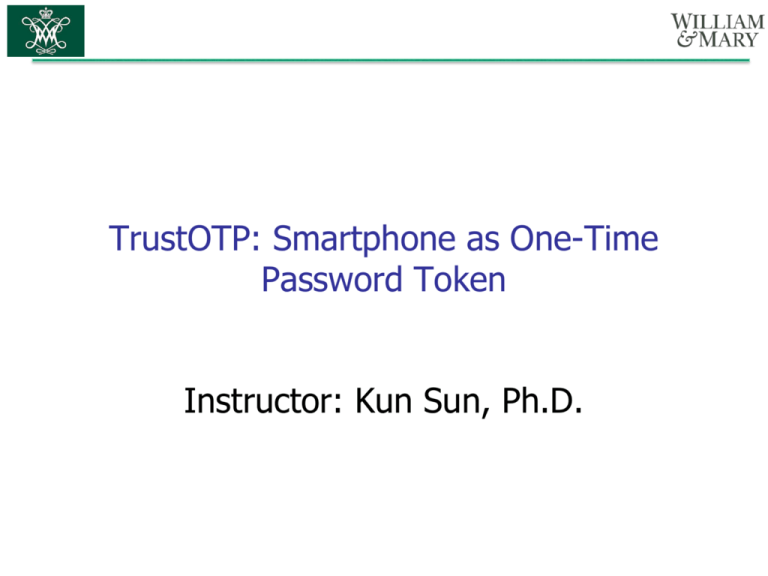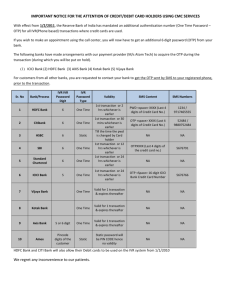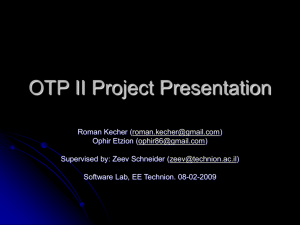TrustOTP: Smartphone as One
advertisement

TrustOTP: Smartphone as One-Time Password Token Instructor: Kun Sun, Ph.D. Outline Introduction Background Design & Implementation Evaluation Related work Summary 2 Outline Introduction Background Related work Design & Implementation Evaluation Summary 3 One-time Password (OTP) A password that is valid for only one login session or transaction Not vulnerable to replay attacks Widely used in Two-factor Authentication HOTP (Hash-based) & TOTP (Time-based) Hardware Token & Software APP 4 Existing Solutions Hardware-based Software-based RSA SecurID Yubikey Google Authenticator McAfee One-time Password Limitations Hardware: not flexible Unprogrammable Software: not secure Vulnerable to external attacks 5 Outline Introduction Background Related work Design & Implementation Evaluation Summary 6 TrustZone Background TrustZone A system-wide approach Change Two isolated execution mode domains: secure domain and normal domain TZIC (TrustZone Interrupt Controller) Secure interrupt--FIQ Non-secure interrupt-IRQ GPIO (General Purpose I/O) SCR.NS=0 SCR.NS=1 Monitor SMC or other methods SMC Supervisor FIQ …… System Set NS=1 Supervisor FIQ …… System Non-secure Privileged Mode Secure Privileged Mode other than Monitor Mode User User Non-secure State Secure State Change mode 7 Outline Introduction Background Related work Design & Implementation Evaluation Summary 8 TrustZone-related work TrustICE (Sun et al.[1]) SeCReT (Jang et al.[2]) Real-time kernel protection in the normal domain TrustDump (Sun et al.[4]) Secure channel between secure domain and normal application Hypervision (Azab et al.[3]) Isolated Computing Environment in the normal domain Reliable Memory Acquisition of the mobile OS Smartphone as location verification token for payments (Marforio et al.[5]) Trusted Language Runtime for trusted applications in the secure domain (Santos et al.[6]) 9 Outline Introduction Background Related work Design & Implementation Evaluation Summary 10 One-time Password on Smartphone Integrate physical tokens into smartphone Requirements: Security Malicious mobile OS cannot compromise the keying material in the one-time password (OTP) generator It cannot read the OTP Reliability and Availability OTP works even if mobile OS crashes Trusted inputs (e.g., clock time) for the OTP generator Trusted display 11 TrustZone-based Solution ARM TrustZone Technology Two isolated execution environments Mobile OS cannot access the disk, memory, CPU states of the OTP generator. A secure clock for OTP generator A self-contained display and touchscreen. 12 TrustOTP Framework In the Secure domain Shard I/O device with the Rich OS Reliable switch between domains Normal Domain Secure Domain Rich OS Non-secure Permanent Storage Touchscreen Driver User Input of the Rich OS TrustOTP Secure Permanent Storage Non-secure Framebuffer Reliable Switch OTP Generator Display with Touchscreen Secure Clock HOTP Secure Counters Secure Framebuffer Secure Display Controller Framebuffer Driver TOTP Secure Touchscreen Driver User Input of TrustOTP 13 Boot Sequence Secure storage Secure Domain MicroSD card USB Flash Drive Memory Isolation MicroSD card Normal Domain Kernel Filesystem Watermark Mechanism Non-secure TZASC (TrustZone Memory Address Space Controller) Non-secure Bootloader TrustOTP Secure Bootloader 2 1 TrustOTP Secure Bootloader 4 3 Kernel Non-secure Bootloader Secure Memory Secure boot Secure bootloader Non-secure bootloader Rich OS 14 TrustOTP Trigger Reliable switch Non-maskable interrupt (NMI) Secure interrupt (FIQ) The Rich OS cannot block or intercept The Rich OS cannot manipulate Interrupt source (Configurable) Physical button Timer 15 OTP Generation Hash-based One-time Password (HOTP) Event triggered Key & Counter Time-based One-time Password (TOTP) Time synchronized Key & Clock 16 OTP Display Secure I/O Display: IPU (Image Processing Unit)+LCD Input: 4-wire resistive touchscreen User-friendly manner Rich OS and TrustOTP run concurrently Watchdog timer 1.5 seconds / cycle (Through experiment) 0.5 second for display 1 second for input 2~3 numbers 17 Security Analysis Information Leakage Control Flow Tampering Generated OTPs Shared Keys Code Integrity Execution Integrity (Interrupt) Denial-of-Service Switch between domains Static & dynamic code Display 18 Outline Introduction Background Related work Design & Implementation Evaluation Summary 19 TrustOTP Performance Before OTP display (60.48 ms) Step Operation Time (ms) 1 Domain Switching 0.002 2 Context Saving 0.0006 3 TOTP/HOTP Generation 0.048/0.044 4 Background Matching 49.85 5 OTP Drawing 8.029 6 IPU Check 2.22 7 Framebuffer Replacement 0.28 After OTP display (7.52 ms) Step Operation Time (ms) 1 Flushing IPU & Rich OS Recovery 7.47 2 Domain Switching 0.05 20 Impact on the Rich OS Rich OS vs. TrustOTP Antutu CPU & RAM I/O devices Vellamo 21 Power Consumption Rich OS TrustOTP Running Average=2,128 mW Average=2,230 mW TrustOTP without Display Outline Introduction Background Related work Design & Implementation Evaluation Summary 23 Summary TrustOTP: Hardware-assisted OTP Token Security (Confidentiality, Integrity, Availability) Flexibility (Various and multiple ICEs) Little Impact on the Rich OS No need to modify the Rich OS Little Power Consumption Difference 24 References 1. 2. 3. 4. 5. 6. H. Sun, K. Sun, Y. Wang, J. Jing, and H. Wang, “TrustICE: Hardware-assisted Isolated Computing Environments on Mobile Devices,” in Proceedings of the 45th Annual IEEE/IFIP International Conference on Dependable Systems and Networks (DSN’15), June 22-25, 2015. J. Jang, S. Kong, M. Kim, D. Kim, and B. B. Kang, “Secret: Secure channel between rich execution environment and trusted execution environment,” in 21st Annual Network and Distributed System Security Symposium, NDSS 2015, February 8-11, 2015. A. M. Azab, P. Ning, J. Shah, Q. Chen, R. Bhutkar, G. Ganesh, J. Ma, and W. Shen, “Hypervision across worlds: Real-time kernel protection from the ARM trustzone secure world,” in Proceedings of the 2014 ACM SIGSAC Conference on Computer and Communications Security, November 3-7, 2014. H. Sun, K. Sun, Y. Wang, J. Jing, and S. Jajodia, “Trustdump: Reliable memory acquisition on smartphones,” in Proceedings of 19th European Symposium on Research in Computer Security (ESORICS’14), September 7-11, 2014. C. Marforio, N. Karapanos, C. Soriente, K. Kostiainen, and S. Capkun, “Smartphones as practical and secure location verification tokens for payments,” in 21st Annual Network and Distributed System Security Symposium, NDSS 2014, February 23-26, 2014. N. Santos, H. Raj, S. Saroiu, and A. Wolman, “Using ARM trustzone to build a trusted language runtime for mobile applications,” in Architectural Support for Programming Languages and Operating Systems, ASPLOS ’14, March 1-5, 2014 25





